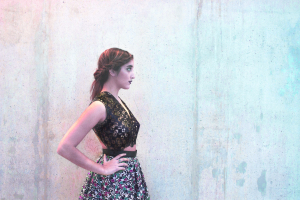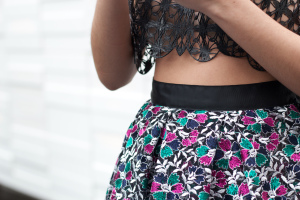
This article originates from Women In 3D Printing and is part of our effort to support the use of 3D printing technology by women. The article is re-published with permission.
Stephania went from studying all about the fashion industry to Tech, through IOT and wearable technology. Her creations combine mystery and fantasy and she always has in mind to make the viewer believe they live in a different world. She is currently working at Ryerson University’s Digital Media Experience Lab (DME) teaching and assisting Undergraduate and Graduate students with 3D Printing and Wearable Technology projects.
Nora Toure: Stephania, could you let us know about your background and what brought you into 3D printing in the first place?
Stephania Stefanakou: I was always interested in Wearable Technology through all my four years in Fashion Communication. Last September I started doing research for my Thesis Project, improving the wearable technology market for the female consumer. I looked at emerging technologies and how each one could benefit the fashion industry. When I came across 3D Printing and some of the work that designers have created already I was fascinated and wanted to do some experimentation of my own. The university I attended, Ryerson University, had a digital media lab, the DME, and they had 3d printers accessible to students so I started learning how to use them with the help of Husain Nizami (Husain Nizami is the person that taught me how to 3D Print and helped me do research and experiments with flexible filament. He is now also my mentor for my new startup STEFANAKOU and gives me advice on different ways to 3d print better on fabric). My thesis project was divided into two parts, a paper and a creative project. After doing enough research I decided that the creative part would be a 3D printed flexible crop top. I designed my own 3D textile design featuring organic elements of nature to show how wearable technology does not have to be something cold and techky but something natural and warm. FilaFlex has assisted me by creating a fabric-like feeling to the shirt and allowing the wearer to be feel comfortable while wearing due to its flexibility and durability.

Nora Toure: Could you describe your very first experience with a 3D printer?
Stephania Stefanakou: The first time I ever used a 3d Printer at the DME I was mind blown at how fast it could create something. The hardest part for me was to learn and understand the different setting each filament needs depending on the 3D Printer you use. It took me about 3 weeks to learn how to use properly the Lulzbot Taz 5 and the Hyrel 30M using PLA in the beginning and then FilaFlex. Husain and I did a lot of experiments 3D printing flexible flower petals to test the quality and it took us about a month and 12 different flower petal prototypes to get them perfect.
Nora Toure: What exactly is the Digital Media Experience Lab (DME)? What do you do for this Lab?
Stephania Stefanakou: The DME is part of Ryerson University’s library. It is a lab that educates students and professors about all the emerging technologies and assists them with their projects. While I was working on my thesis project in the lab I would always help other students with their 3d printed projects so eventually, I got a job there. Now I am the Wearable Tech and 3D Printing advisor and I help students and professors from any faculty and program with their ideas.
Nora Toure: 3D Printing and Wearable Tech – Why does is make sense to combine those technologies?
Stephania Stefanakou: From a fashion perspective, 3d printing can revolutionize wearables. Every day new filaments are created, eco-friendly and with fewer chemicals, making it easy to create garments and jewelry out of them. 3d printing has evolved so much that you can now 3d print electronics with printers such as Voxel8. Instead of having wires tangled all over a shirt you could just 3d print a shirt with all the electronics already in place. You could create prototypes of wearable devices such as bracelets or watches faster now that 3d printing and electronics come together.
Nora Toure: You are the founder of House of Anesi. What is it and how did you come to build the company?
Stephania Stefanakou: House of Anesi is a start up business at the Fashion Zone, a Canadian incubator, led by two engineers and one fashion student. Anesi is about reimagining the future of bras by leveraging the latest smart materials, technology and engineering fundamentals. We are creating a smart bra that will give women a perfect fit, automatically adjust to breast size changes and give extra support and comfort. The idea was born last year during the Re-Engineering Fashion competition that was held at Ryerson University. Our business idea won the competition and $1000 and since then we have won two Norman Esch Awards from the Engineering Department of Ryerson University.

Nora Toure: Do you have any (fun or not) story about your experience in the 3D Printing industry to share with us?
Stephania Stefanakou: One story that I have seems really funny to me now but got me to tears a few months ago: It was this past February and I was in the DME lab waiting for the last piece of my crop top to be printed. Around 6pm while my print was 60% done, the computer that was connected to my printer just shut down on its own to do an automatic update and my print just stopped. However, I did not see that right away so the extruder just stopped working but it was still hot enough for the filament to melt all around the nozzle and the print. It took me an hour to clean and set up everything. Around 11pm, I had already restarted my print and it was 90% done, the computer software froze and was not working at all so the printer froze as well and did the exact same mess as before. After a good cry and sleep, I went back to the lab the next morning, updated everything on the computer and made sure everything worked fine and 3 hours later my last piece was complete.
Nora Toure: As a woman entrepreneur, what is your biggest challenge? Any challenge specific to the 3D printing industry?
Stephania Stefanakou: I think my biggest challenge as a woman entrepreneur is having a background in fashion. When students ask me at the lab what program I finished, it seems to really surprise them when I tell them Fashion Communication because their automatic response is “How do you know 3D Printing then?”. Another response I get a lot when people ask me about my startup “House of Anesi” is if I am just the seamstress of the team. It seems since I studied fashion I shouldn’t know anything about 3d printing, wearable technology and running a business. 3d printing is such an amazing industry for everyone to be involved with but it seems that there are some people that think that only someone with an engineering background belongs in it.
Nora Toure: Anything exciting coming up you’d like us to know about?
Stephania Stefanakou: In September I started the process of creating my own 3d printed collection. I am going to be 3d printing on fabric and create garments such as jackets, shirts and vests. 3d printed embroidery and embellishments creating beautiful designs on different types of fabric. I will be documenting the entire process and all the different techniques I will be using to get the best results. My goal is to have the first pieces on my website for sale this month (December 2016) – My website is available here. You can also follow the process work on my Instagram account.
Nora Toure: What was the most impressive or impactful use of 3D printing you’ve seen so far?
Stephania Stefanakou: The most impressive use of 3D Printing was Danit Peleg’s 3D collection. She was my inspiration from the beginning when I found out about 3D Printing, that it is possible to create something so unique with a simple 3D printer. In addition, I was amazed when I learned that it is possible nowadays to 3D Printing human body parts like an ear or bones. That will change people’s lives for the best.
Nora Toure: What makes the 3D printing industry particularly interesting for you as a business person?
Stephania Stefanakou: It allows me to make the prototypes of my ideas fast and I am able to see if it will work. 3D printing was a big necessity for my startup “House of Anesi” to test some parts of the bra and see how they can work, what modifications we need to do, what materials work best.
Nora Toure: As a woman?
Stephania Stefanakou: The 3D printing industry allowed me to show that women even with a fashion background can create beautiful things with technology. The tech industry and specifically the 3d printing industry is not a place yet that you see many women in. I am really happy that I am able to show to all the students from my university that come to the DME lab that women can be in this industry and encourage female students to get involved as well.
Nora Toure: What do you think of the 3D printing industry today? And how would you like to see it evolve?
Stephania Stefanakou: The 3D printing industry has made so much progress over the last few years, helping people and businesses create things faster and at a lower cost. We have already achieved at creating 3d printed clothing, 3d printed prosthetics and human body parts, even 3d printed coral reefs. I believe our imagination will help us create extraordinary things that will help our everyday lives. If 3D printed fashion becomes more of a normality in the next years we could probably give an end to fast fashion or at least help a bit more towards a more eco-friendly and ethical fashion.
Nora Toure: In your opinion, how could we encourage more women to become involved with 3D Printing?
Stephania Stefanakou: I believe that if we introduce 3d printing to women from an early stage of their education, such as high school and university and teach them more about 3d modelling, we would see them more involved in the industry. In addition, we would not only see them more involved with the 3d printing industry but also in the startup industry since it will become easier for them to create their prototypes and eventually build their own business.
If you are interested in learning more about Stephania, I recommend checking her website, DFZ (Digital Fabrication Zone).
And don’t forget to join the Women in 3D Printing group on LinkedIn and Facebook.
Thank you for reading and for sharing!

